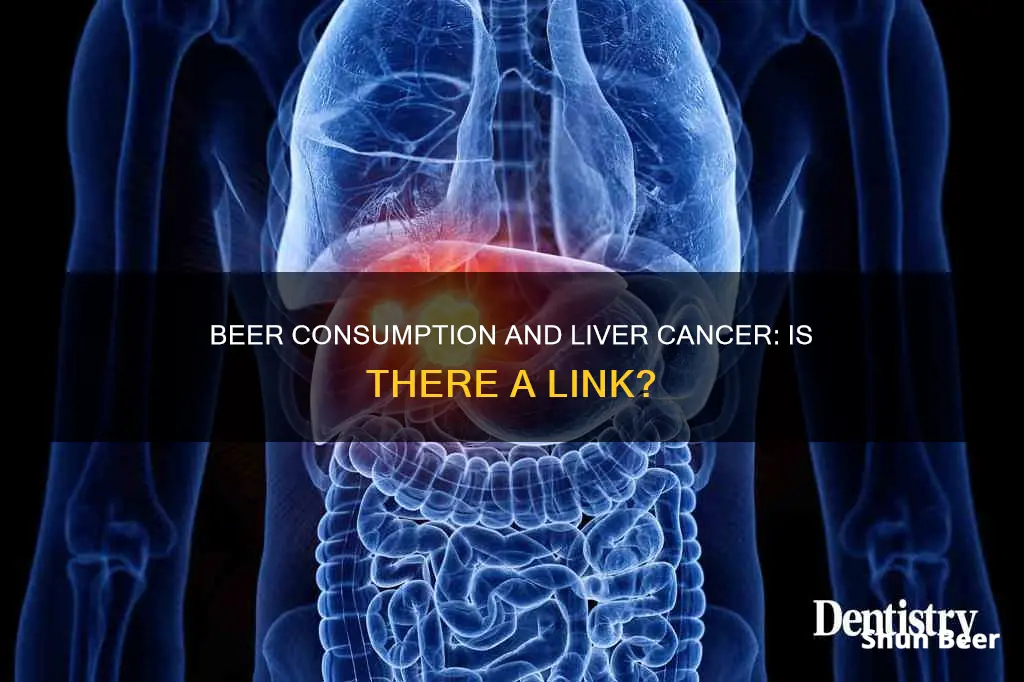
Alcohol consumption is a well-known preventable risk factor for cancer. Drinking alcohol, even in small amounts, is linked to an increased risk of liver cancer. While alcohol itself does not cause cancer in the liver, chronic liver damage caused by long-term alcohol use increases the likelihood of developing liver cancer. This damage includes cirrhosis, inflammation, and scarring of the liver, which can lead to liver failure. The risk of liver cancer increases with the amount and regularity of alcohol consumption, and it is recommended to limit alcohol intake or abstain completely to reduce the risk.
| Characteristics | Values |
|---|---|
| Alcohol consumption and liver cancer | Alcohol consumption is linked to an increased risk of liver cancer. Heavy, long-term alcohol consumption is a common cause of cirrhosis of the liver, which can lead to liver cancer. |
| Risk factors | The risk of liver cancer increases with the amount and frequency of alcohol consumption. Even low levels of drinking can increase the risk. |
| Combination with other substances | Drinking alcohol and smoking tobacco together significantly increases the risk of developing liver cancer compared to drinking or smoking alone. |
| Preventative measures | Reducing alcohol consumption lowers the risk of liver cancer. Abstaining from alcohol is the most effective way to prevent liver cancer. |
| Treatment | Early diagnosis of liver cancer improves the chances of survival. If cirrhosis is diagnosed early, it can be treated, and the liver has the ability to heal and replace damaged tissue. |
What You'll Learn
- Alcohol causes fat accumulation in the liver, which can lead to inflammation, cirrhosis, and cancer
- The risk of liver cancer increases with the amount and regularity of alcohol consumption
- Alcohol consumption is linked to a higher risk of several types of cancer, including liver cancer
- Cirrhosis caused by alcohol consumption is a leading condition that increases the likelihood of liver cancer
- The combination of alcohol and tobacco increases the risk of developing liver cancer

Alcohol causes fat accumulation in the liver, which can lead to inflammation, cirrhosis, and cancer
Alcoholic fatty liver disease, also known as steatotic liver disease, is caused by heavy alcohol consumption. This disease occurs when fat builds up inside the liver cells, leading to an enlarged liver. While steatotic liver disease is often asymptomatic, it can cause upper belly discomfort, tiredness, and weakness.
The liver is responsible for breaking down alcohol. However, when the amount of alcohol consumed exceeds the liver's processing capacity, it can lead to severe damage. Alcoholic fatty liver disease is specifically associated with long-term unhealthy alcohol use.
The progression of alcoholic fatty liver disease can lead to alcoholic hepatitis, an acute inflammation of the liver characterised by liver cell death and permanent scarring. This stage is followed by alcoholic cirrhosis, which involves the destruction of healthy liver tissue and its replacement with scar tissue. Cirrhosis is a primary condition that significantly increases the risk of liver cancer.
The accumulation of fat in the liver due to alcohol consumption can trigger a chain of events that ultimately increase the likelihood of liver cancer. The damage caused by alcohol can lead to inflammation and cirrhosis, which are critical precursors to cancer. Therefore, it is essential to address and treat alcoholic fatty liver disease to prevent more severe health complications.
To reduce the risk of developing liver cirrhosis and liver cancer, it is recommended to drink in moderation or abstain from alcohol altogether.
Drinking Beer in Truck Beds: Is it Legal?
You may want to see also

The risk of liver cancer increases with the amount and regularity of alcohol consumption
The Risk of Liver Cancer and Alcohol Consumption
Drinking beer can increase the risk of developing liver cancer, but it is important to understand the relationship between alcohol consumption and this health risk. The link between alcohol and liver cancer is indirect, but the risk increases with the amount and regularity of drinking.
The Link Between Alcohol and Liver Cancer
Alcohol consumption is linked to an increased risk of developing liver cancer, but this risk is not solely dependent on alcohol. Liver cancer is often associated with cirrhosis, which is the late-stage liver scarring caused by excessive alcohol consumption. Cirrhosis can also be caused by other factors, such as hepatitis B or C infections and non-alcoholic fatty liver disease. However, alcohol abuse can lead to cirrhosis, and those with cirrhosis are more likely to develop liver cancer.
Amount and Regularity of Alcohol Consumption
The risk of liver cancer increases with the amount of alcohol consumed and the regularity of drinking. Even low levels of alcohol consumption can be harmful, and the risk of liver cancer rises with increased drinking over time. This means that drinking smaller amounts of alcohol consistently can be more harmful than occasional binge drinking. The evidence suggests that the amount of alcohol consumed over time is a more critical factor in raising the risk of liver cancer than the type of alcoholic beverage.
Recommendations to Reduce Risk
To reduce the risk of liver cancer, it is best to abstain from alcohol consumption. If individuals choose to drink, limiting consumption is crucial. The recommended limits are no more than two drinks per day for men and one drink per day for women. These limits are based on factors such as body size and the rate at which the body breaks down alcohol. For those diagnosed with cirrhosis, abstinence from alcohol is mandatory to prevent further damage and reduce the risk of liver cancer and liver failure.
Beer for Slugs: Does It Work?
You may want to see also

Alcohol consumption is linked to a higher risk of several types of cancer, including liver cancer
Alcohol consumption is a well-known preventable risk factor for cancer, and it has been linked to a higher risk of several types of cancer, including liver cancer. According to the National Institute on Alcohol Abuse and Alcoholism, alcohol consumption can lead to a higher risk of developing certain cancers, and this risk increases with the amount of alcohol consumed over time.
Liver cancer is one of the cancers most closely associated with alcohol consumption. Heavy and long-term alcohol use can lead to chronic liver damage, including cirrhosis, or scarring of the liver. Cirrhosis is a leading cause of liver cancer, as the scar tissue that builds up can interfere with the liver's function and increase the likelihood of cancerous growth. Even low levels of alcohol consumption can be harmful, as the liver can produce toxic substances from alcohol, even before cirrhosis develops, which may contribute to liver cancer.
The link between alcohol and liver cancer is particularly strong in individuals who also smoke tobacco. The combination of alcohol and tobacco use has been shown to increase the risk of liver cancer to a greater extent than either factor alone. Additionally, alcohol consumption has been associated with an increased risk of head and neck, breast, colorectal, esophageal, stomach, and pancreatic cancers.
The mechanism by which alcohol increases the risk of cancer is not fully understood, but several factors are thought to be involved. Alcohol can act as an irritant, damaging cells in the mouth and throat, and leading to DNA changes that can contribute to cancer. Alcohol can also be converted into acetaldehyde, a toxic chemical and probable human carcinogen, in the body. Additionally, alcohol consumption can lead to oxidative stress in cells, resulting in the production of reactive oxygen species that can damage DNA and increase the risk of cancer.
It is important to note that the less alcohol an individual consumes, the lower their risk of cancer. Complete abstinence from alcohol is recommended by several health organizations to minimize the risk of cancer and other alcohol-related health issues. For individuals who choose to drink, moderation is key, with recommendations typically limiting consumption to no more than two drinks per day for men and one drink per day for women.
Beer Chugging: Healthy or Harmful?
You may want to see also

Cirrhosis caused by alcohol consumption is a leading condition that increases the likelihood of liver cancer
Alcohol consumption is a leading cause of cirrhosis, which, in turn, is a leading cause of liver cancer. Cirrhosis is a condition in which healthy liver tissue is replaced by scar tissue, and the liver stops functioning correctly. Alcohol-associated cirrhosis is caused by long-term unhealthy alcohol use.
Alcohol is the common term for ethanol or ethyl alcohol, a chemical substance found in alcoholic beverages such as beer, hard cider, malt liquor, wines, and distilled spirits (liquor). Alcohol consumption leads to liver damage through endotoxins, oxidative stress, and inflammation. The liver's job is to break down alcohol, and if you drink more than it can process, it can become badly damaged.
The more alcohol a person drinks, particularly over time, the higher their risk of developing alcohol-associated cancer. Alcohol consumption at any level is associated with an increased risk of a type of oesophageal cancer called oesophageal squamous cell carcinoma. Heavy alcohol consumption is associated with a twofold increased risk of two types of liver cancer: hepatocellular carcinoma and intrahepatic cholangiocarcinoma.
According to the National Institute on Alcohol Abuse and Alcoholism, a standard alcoholic drink in the United States contains 14 grams of pure alcohol. Generally, this amount of pure alcohol is found in 12 ounces of regular beer. The CDC recommends that you drink in moderation, defined as having up to one drink per day for women and up to two drinks per day for men.
Lip Piercing and Beer: What You Need to Know
You may want to see also

The combination of alcohol and tobacco increases the risk of developing liver cancer
Alcohol and tobacco are both associated with an increased risk of developing several types of cancer, including liver cancer. The combination of alcohol and tobacco use has a multiplicative effect on an individual's likelihood of developing cancer.
Alcohol consumption is linked to an increased risk of liver cancer, particularly in the form of hepatocellular carcinoma (HCC) and intrahepatic cholangiocarcinoma (ICC). Long-term and heavy alcohol use can lead to chronic liver damage, including cirrhosis, which is a primary condition that increases the risk of liver cancer. The more alcohol a person consumes, especially over a long period, the higher their risk of developing liver cancer.
Tobacco smoking is also a well-established risk factor for liver cancer, particularly HCC, which is the most common type of primary liver cancer. Current smokers have an increased risk of developing HCC, and the risk increases with the amount and duration of smoking.
When it comes to the combination of alcohol and tobacco use, studies have shown a multiplicative effect on the risk of developing liver cancer. This means that the risk associated with the combined use of alcohol and tobacco is greater than the sum of the individual risks associated with each habit. The positive correlation between alcohol consumption and tobacco smoking further complicates the separation of their individual effects on liver cancer risk. However, some studies have reported an interaction between alcohol drinking and tobacco smoking in relation to HCC risk, indicating that they may have a synergistic impact.
In summary, while alcohol and tobacco are independent risk factors for liver cancer, their combined use significantly increases the likelihood of developing this disease. The exact relative risks associated with their combined use are still being studied and discussed.
Wellbutrin and Beer: Is It Safe to Mix?
You may want to see also
Frequently asked questions
Drinking beer can cause liver cancer. The risk of developing liver cancer increases with the amount of alcohol consumed, especially if consumed regularly.
The recommended limit is no more than two drinks per day for men and one drink per day for women. However, to reduce the risk of liver cancer, it is best not to drink alcohol at all.
Some signs and symptoms of liver cancer include unexpected weight loss, loss of appetite, nausea, vomiting, stomach pain, jaundice (yellowing of the skin and eyes), and fatigue. If you experience any of these symptoms, seek medical advice promptly.







